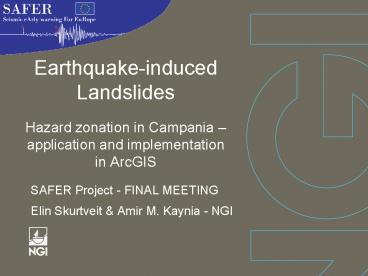Earthquake-induced Landslides Hazard zonation in Campania
1 / 17
Title:
Earthquake-induced Landslides Hazard zonation in Campania
Description:
Initial objectives Calibrate a land susceptibility model based on topographic and lithological properties of slope and combine it with a deterministic model ... –
Number of Views:105
Avg rating:3.0/5.0
Title: Earthquake-induced Landslides Hazard zonation in Campania
1
Earthquake-induced LandslidesHazard zonation in
Campania application and implementation in
ArcGIS
- SAFER Project - FINAL MEETING
- Elin Skurtveit Amir M. Kaynia - NGI
2
Initial objectives
- Calibrate a landslide susceptibility model based
on topographic and lithological properties of
slope and combine it with a deterministic model
based on - mechanical parameters of the soil
- geometrical properties of the slope
- characteristics of the earthquakes
- Validate the model through documented case
histories and database of historical landslides. - Establish a GIS-based methodology to couple
landslide model to Shake maps in order to produce
real-time slide maps. - In cooperation with AMRA and using the shake maps
generated in WP2, apply the seismic landslide
susceptibility model to a study region in
Campania, Italy. - Establish a model for pore pressure
generation/dissipation under cyclic loading of
earthquake and develop computational tool for
post-earthquake landslides.
3
Outline of presentation
- Empirical Slope Deformation Analysis
- Verification of models for landslide prediction
- Implementation of landslide prediction model in
ArcGIS - Application of ArcGIS model to test site in
Campania, Italy
4
Empirical Slope Deformation Analysis
Factor of Safety
Why Translational Slide Model? Failures in
natural slopes are typically shallow and they
have small thickness to length ratios
c soil cohesion h slab thickness b slope
angle f internal friction angle of soil g ,gw
unit weight of soil and water n percentage of
saturated slab thickness
Yield Acceleration of Slope
ay yield acceleration of the slope (Applied in
the direction parallel to slope)
5
Empirical Slope Deformation Analysis
Sliding Displacement Prediction Models
California Method (Blake et. al. 2002) The
predictive equation developed by Bray and Rathje
(1998) is presented in Recommended Procedures for
Implementation of DGM Special Publication 117
Guidelines for Analyzing and Mitigating Landslide
Hazards in California
u permanent displacement in centimetres D5-95
Significant duration parameter (time difference
between 5 and 95 development of Arias
Intensity) kmax maximum horizontal equivalent
loading coefficient Standard error for this
equation is 0.35 in log 10-units (Limited number
of strong motions used were available)
Bray and Rathje (1998)
6
Empirical model of landslide
1. Establish Factor of safety against failure (H
depth to sliding, C soils shear strength)
2. Calculate yield acceleration of slope
3. Calculate slopes displacement (D5-95
significant duration, kmax peak ground
acceleration in g)
7
Verification of model for landslide prediction
Four Case histories of observed landslide or
large slope displacements were used
- Landslide movement during Northridge Earthquake
- Debris slump caused by Suusamyr Earthquake
- Yokowatashi landslide during Niigata-Ken Chuetsu
earthquake - Landslide movement during Coyote Lake Earthquake
8
Verification of model (cont.)
Results of comparisons with case histories of
landslides are encouraging and indicate a fairly
good performance of the model.
The model is also able to explain the upper bound
of historical landslides, established by Keefer
(1984), as function of distance and earthquake
magnitude.
This model is being implemented in a GIS for
mapping of landslide zones
9
Application of ArcGIS Model to test site in
Campania, Italy
- Study area Campania
- Destra Sele River Basin
- Available data (provided by AMRA and INGV)
- Digital elevation model
- Geology
- Geotechnical parameters
- Shake Map
Irpinia 1980 earthquake
10
Earthquake data
- Peak Ground Acceleration map from the Irpinia
1980 earthquake
Provided by INGV
11
Geology of the Study area
12
Implementation of landslide prediction model in
ArcGIS
Raster Calculation and Map Algebra
functions. Example
The result of Inlayer1 Inlayer2 / 2 results
in an output grid displaying the mean value for
every cell.
Raster slope map calculated from Digital
Elevation Model Cellsize 40 m x 40 m
13
Implementation of landslide prediction model in
ArcGIS
- Input raster layers
- Geology geotechnical parameters
- Geometry of slope
ArcGIS Raster calculation model for factor of
safety and the yield acceleration of the soil
14
Implementation of landslide prediction model in
ArcGIS
Calculate slopes displacement, u
- Input raster layers
- PGA
- Soil strength / safety factor
- Magnitude and distance
D5-95 significant duration, kmax peak ground
acceleration in g
Raster calculation model for soil displacement
15
ArcGIS displacement map
Slope Displacement in cm
16
Sliding Displacement Evaluation Comparison with
the Extended Models
Reference Saygili and Rathje (2008) Saygili and Rathje (2008) Bray and Travasarou (2007) Blake et. al. (2001)
GM Parameters PGA,M PGA,PGV PGA PGA, D5-75
Min Displacement 0 cm 0 cm 0 cm 0 cm
Max Displacement 76 cm 78 cm 97cm 171 cm
0 - 5 cm 99.44 99.44 99.41 99.37
5 - 15 cm 0.31 0.32 0.34 0.26
15 - 30 cm 0.11 0.10 0.07 0.12
gt 30 cm 0.14 0.13 0.18 0.25
- The results from various recent models compare
very well with the California Model - ShakeMaps indicate that PGA and PGV values range
from around 0.05 to 0.15 g and 5 to 20 cm/s over
most of the slopes, respectively. - It is observed that the zones corresponding to
the sliding displacements greater than 5 cm cover
a very small portion (around 0.55) of the study
region. The reasons for low hazard potential are - Slopes have relatively high shear strength
- Severity of the ground shaking is not strong
17
Conclusions
- Verification of slope displacement model for
landslide prediction using case histories. - Application of landslide prediction model to test
site in Italy. - Results shows how a GIS-based method can be
implemented for near real-time prediction and
mapping of landslides. - Results from various recent slope deformation
models compare very well with the California
Model used in this study.






























